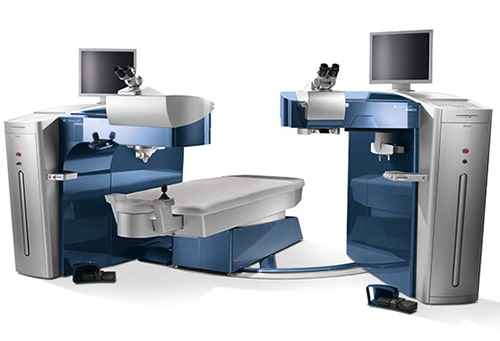Our Technology
State-Of-The-Art Technology


When it comes to ensuring that his patients get the latest treatment available, cost is not an option for Dr. Rahmani. That’s why each piece of equipment used at the Rahmani Eye Institute, from the diagnostic instruments to the surgical treatment tools, are the latest technology available in laser vision correction and treatment.
For Dr. Rahmani’s patients, the advanced technology means that his patients can receive all of their care — from initial evaluations to surgical procedures to post–surgical follow–up care — in one convenient location.
iFS Advanced Femtosecond Laser
The Intralase iFS Advanced Laser provides an all–laser approach to lasik surgery. It uses the laser to create the corneal flap and is the 5th generation and most advanced INTRALASE Laser. Not only does it have a new level of safety assurance but the computer–controlled laser provides unprecedented control and the ability to customize the flap for each of our patients.
The iFS Laser provides the ideal combination of advantages: minimal disruption of corneal architecture, stronger flaps, fewer possible complications plus faster visual recovery.
VISX Waveprint™ System
No two people are the same. Like your DNA or your fingerprints, your eyes are unique. Previously, laser vision correction treatment was based on diagnostic technology that has been used for prescriptions of contacts and sunglasses. The new Waveprint System by VISX takes a step up in laser vision correction technology by combining personalized diagnostics and the Excimer laser into one system.
Wavefront Diagnostic Technology
In the past, laser vision technology has always treated patients by using their optical prescription. Exiting news!! Today with the introduction of Wavefront Diagnostic Technology, our Wavefront Guided Excimer Laser is able to treat patients according to each individual prescription.
Corneal Topography
Corneal Topography creates a three–dimensional map of the cornea. An eye with normal vision has an evenly rounded cornea. Patients with irregular vision often have either too flat, too steep or unevenly curved corneas. Corneal Topography can detect this by producing a detailed, visual description of the cornea.
VISX STAR S4™ Excimer Laser System
This advanced technology offers faster treatments using variable spot beam technology and an eye tracking system which tracks in all three dimensions.
